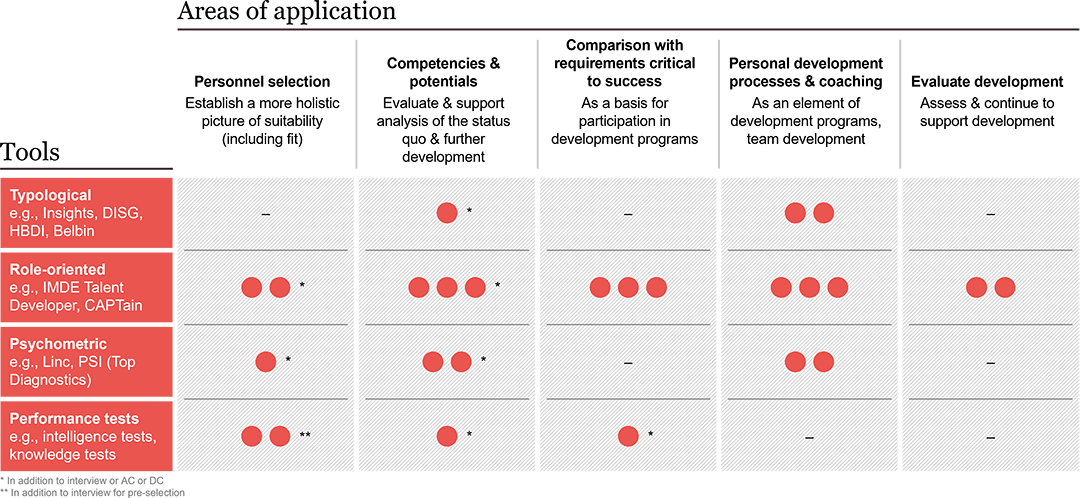Potential analysis and reflection tools for team and individual development
- Which tools support development, reflection, improvement of communication and team development efficiently and effectively?
- Which tools are perceived by participants as meaningful and supportive?
- What are useful decision criteria for tool selection?
- How can tools improve and intensify HR processes - recruiting, talent management, performance management, competence management, etc.?
- What are important factors when using tools to ensure that they are effective and accepted?
The conscious analysis of one's own strengths, development areas and potentials can open our eyes to new perspectives and previously untapped knowledge.
The market for diagnostic tools offers a wealth of potential analysis & reflection tools. Some of them promise a very wide range of possible applications or are tailored to very specific application questions. At 5P, we have been successfully using various tools for 20 years. For us, it is not just a question of the tool itself, but the effective and appropriate integration of tools into selection or development processes. Correctly selected tools only develop their full impact through transparent communication regarding the process of introduction, evaluation and reflection.
Many good tools provide a compact format for identifying, discussing and reflecting on trends and provide concrete starting points for development, cooperation and communication.

Fig.: How we use diagnostic tools - here: Tools that optimally support reflection processes
The depicted table shows various tools used to support reflection processes in different areas of application. These areas are divided into five categories:
- Personnel Selection: Here, a more comprehensive picture of the candidates' suitability is determined, including their fit for the position.
- Competencies & potentials: This area is used for situational assessment and to estimate and support further development.
- Comparison with requirements critical to success: This category serves as a basis for participation in development programs.
- Personal Development Processes & Coaching: This area focuses on personal development as an element in development programs and team development.
- Evaluating Development: In this area, the participants' development is assessed and further supported.
The table also lists various types of tools used in these categories:
- Typological (e.g., Insights, DISC, HBDI, Belbin)
- Role-oriented (e.g., IMDE Talent Developer, CAPTain)
- Psychometric (e.g., Linc, PSI (Top Diagnostics))
- Performance tests (e.g., Intelligence Tests, Knowledge Tests)
| Type of tool | Focus | Application | |
| IMDE Talent Developer |
Role based Benchmarked Can be calibrated to competence model |
Success factors Attitudes |
Selection Development Coaching |
|
CAPTain Computer Aided Personnel Test answers inevitable |
Role based Can be calibrated to competence model |
Behavioral styles Working style |
Application areas Development Coaching |
| Linc Personality Profiler (LPP) | Psychometric |
Big5 Character, motivation and competencies |
Selection Development Coaching |
| PSI TOP Diagnostik |
Psychometric Projective |
Motivation Self-regulation competencies Personal styles |
Individual reflection and development in coaching, training and as an element of intensive and high-quality development programs |
| Belbin | Typology | Preferences for team roles |
Team development Training |
| Strengthfinder |
Talents: Mindsets, feelings and behaviors |
Training Coaching |
|
| HBDI | Typology | Thinking preferences | Training |
| Insights, AEC Disc | Typology | Personality |
Team development Training |
Approach

Fig.: Steps in the application of diagnostic tools
There are six steps to consider when using diagnostic tools:
- Clarification of critical success factors and, if necessary, calibration of the tools (competence profiles): This step involves defining the key requirements critical for success and, if necessary, adjusting or calibrating the tools to assess the appropriate competencies.
- Clarification of the evaluation and feedback process, as well as information and communication: The process of evaluating the results and providing feedback is established. Additionally, it determines how information will be exchanged and communicated.
- Completing the online questionnaire: The participants complete an online questionnaire that serves as the basis of the analysis.
- Evaluation & report: The data from the questionnaire is evaluated, and a report summarizing the results is created.
- Feedback/coaching session and further clarification of development goals: A conversation in which feedback is provided and development goals are clarified. This may also include a coaching session.
- Implementation steps on- and off-the-job: These are concrete measures to be implemented both during work (on-the-job) and outside of work (off-the-job) to achieve the development goals.
